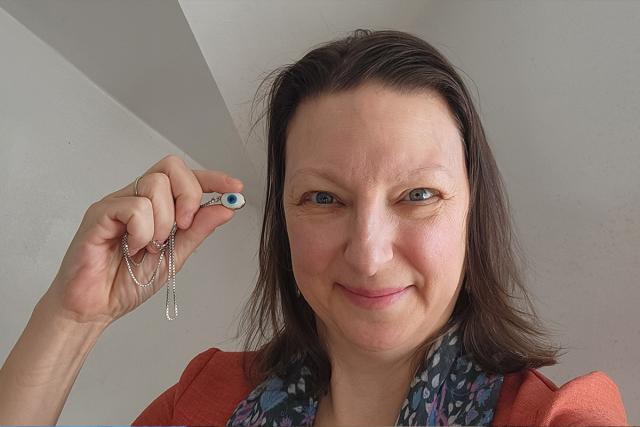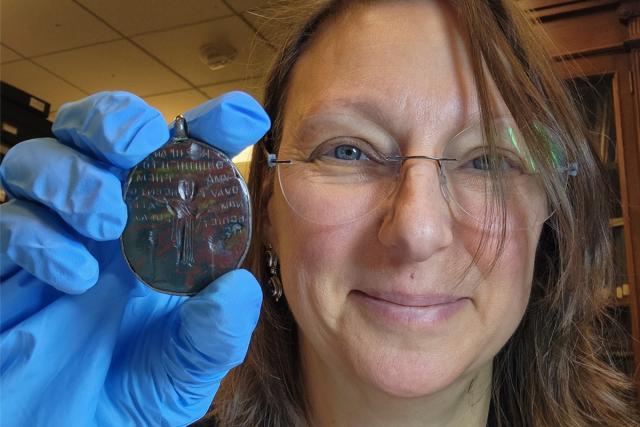Kean Q&A: Jacquelyn Tuerk-Stonberg, Ph.D., Presents Inaugural Art History Lecture on Dark Arts

Kean Associate Professor Jacquelyn Tuerk-Stonberg, Ph.D., will deliver a lecture exploring the world of magical amulets to ward off dangers and fears in ancient and medieval civilizations. Defense Against the Dark Arts, the inaugural lecture of a new, annual Art History Lecture Series, will take place on Tuesday, March 5 from 3:30-4 p.m. in Kean Hall 127. It will also be livestreamed on YouTube.
Tuerk-Stonberg, who is teaching a new art history course on the subject this semester, spoke to Kean News about her research in Byzantine art and magic; the significance of art history; and how people have historically used art to protect themselves from “demons,” with lessons for people today.
Q: Can you tell us about your interest in the dark arts?

My background is in the ancient and medieval history of magical amulets and spells, rooted in my graduate work at the University of Chicago, where I wrote my doctoral thesis on Byzantine art and magic. My early interest in the material history of magic paved the way for numerous publications on that topic. I recently gave talks on medieval magical amulets to scholarly audiences in England, China and Michigan, and I am working on a book.
Being deeply curious about magic, I’ve traveled to 88 different museums across Africa, Asia, Europe and North America in search of real magical amulets and spells. I’ve found thousands of them! I am an art historian but also a social historian, an archaeologist and linguist. So I come to magical amulets, images and spells with true inter-discipline experience. For fun, I have made my own amulets with multi-cultural iconographies, on prescribed gemstones, and with accurate spells—facilitated by my ability to read several ancient languages.
Q: Why is it important to study art history?
Art history is a cornerstone of the humanities. It fully engages with images and material objects of all the other humanities disciplines, to examine and understand human culture. The humanities are central to any intellectual endeavor—they justify the very reasons for the sciences.
Q: What can you tell us about Defense Against the Dark Arts?
I titled my talk after a class at Hogwarts in the Harry Potter books because many of us have come to an appreciation and interest in “magic” through these stories and their heroes and villains. But these books are fiction—products of the author’s imagination—whereas magic was practiced by real people, throughout real history, who defended against real fears and dangers, with real rituals, spells and amulets. Amulets represent the tradition of using images and words on stones, metals and papyrus to protect, heal and sometimes curse. This tradition spans centuries from ancient through medieval cultures, and large areas of geography across the Mediterranean.
This semester I am teaching an upper-level art history course entitled Magical Amulets: Defense Against the Dark Arts.
Q: What should we all know about the Dark Arts?
People are the same wherever and whenever; we all look for ways to understand and soothe our fears, suffering and desires. Although the material and mental objects differ from culture to culture and from individual to individual, the processes are similar: we use words, images, objects, rituals and signs in general to shape our human experience by shaping our perception of it.
The "dark arts" has been understood in several different ways across human cultures. Throughout history and even until our present day, fear and danger are understood to take the form of "demons." In my lecture, I am presenting historical, material evidence of how ancient and medieval people defended themselves against their own demons. But every peoples—in every time, culture and geography—fought against their demons, whether creatures of the air or living deep within our own psyches. I invite my audience to consider the demons within. Where do you locate your own demons? Do we carry them within ourselves? How do you defend against the dark forces in others or in yourself?
Following Defense of the Dark Arts, the new Art History Lecture Series will annually highlight the research of Kean faculty and other scholars. To learn more about the art history minor at Kean, visit https://www.kean.edu/academics/department-fine-arts/art-history.